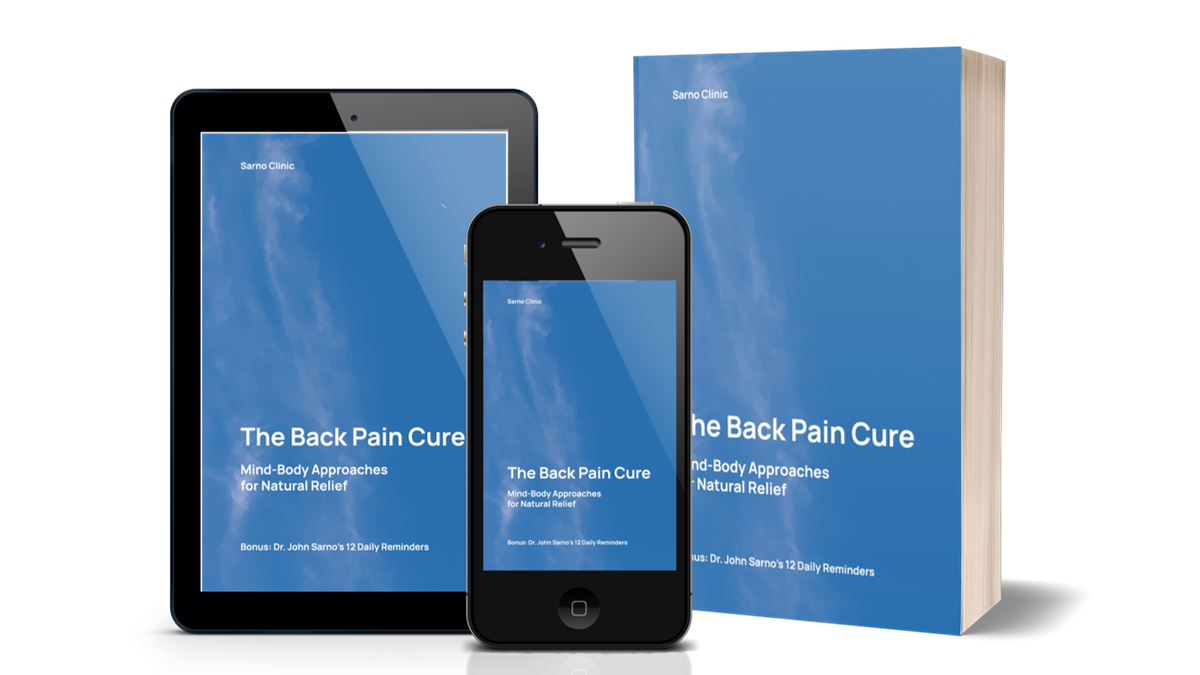“The Back Pain Cure: Mind-Body Approaches for Natural Relief” by Sarno Clinic
Are you tired of chasing relief through medications, endless physical therapy, or the looming threat of surgery - only to find ...

“The Back Pain Cure” Sarno Clinic Edition (Instant downloads for all devices) $9.99 - Buy now
“The Back Pain Cure” Kindle Edition (Instant download for Kindle) $9.99 - Buy now
“The Back Pain Cure” Paperback Edition $19.99 - Buy now
“The Back Pain Cure” Sarno Clinic Edition is the best value with seven file formats for you to read on any device - Apple Books, Google Play, Kindle, Kobo, Nook, Open and PDF. Securely pay with Visa, Mastercard, and more. After purchase, you’ll get download links for all file formats. We’ll also send you a thank you email with your download links and an option to generate an invoice.
“The Back Pain Cure: Mind-Body Approaches for Natural Relief”
Stop wasting time on what doesn’t work.
Are you tired of chasing relief through expensive medications, endless physical therapy, or the looming threat of high-cost surgery - only to find yourself still in pain?
“The Back Pain Cure” offers a radically different approach grounded in cutting-edge mind-body medicine that has helped thousands overcome chronic back pain naturally.
Drawing from Dr. John Sarno’s groundbreaking research on Tension Myositis Syndrome (TMS), this book reveals the surprising truth that most chronic back pain has nothing to do with structural damage and everything to do with your mind.
Your pain is real, but its source isn’t what you think. In this accessible and life-changing book, you’ll learn how to:
- Understand the true mind-body connection behind your pain
- Recognise how repressed emotions like anger and anxiety drive your symptoms
- Break the mental cycle that keeps your body locked in pain
Your recovery from chronic back pain is possible. This book provides you with the knowledge and tools necessary to break free from the prison of pain and reclaim an active, fulfilling life.
“Thousands of people have used these techniques to eliminate years or decades of back pain. They’ve thrown away their heating pads, cancelled their surgery appointments, and returned to hiking, dancing, and playing with their children.” Drew Carroll
“Your back isn’t broken. Your life doesn’t have to be limited. The pain that controls your every decision can become a memory.” Erica Yang
“Stop managing your pain and start eliminating it. Your journey to complete recovery begins with turning the first page.” Jeremy Turvey
“The Back Pain Cure” Sarno Clinic Edition (Instant downloads for all devices) $9.99 - Buy now
“The Back Pain Cure” Kindle Edition (Instant download for Kindle) $9.99 - Buy now
“The Back Pain Cure” Paperback Edition $19.99 - Buy now
“The Back Pain Cure” Sarno Clinic Edition is the best value with seven file formats for you to read on any device - Apple Books, Google Play, Kindle, Kobo, Nook, Open and PDF. Securely pay with Visa, Mastercard, and more. After purchase, you’ll get download links for all file formats. We’ll also send you a thank you email with your download links and an option to generate an invoice.
Sample - Chapter 1 Prison of chronic pain
You wake up and the pain is already there.
Before your feet touch the floor, before your first conscious thought, your back announces itself with that familiar ache. The same grinding sensation that ended yesterday now begins today.
This is chronic back pain, and it has become the unwelcome narrator of your life story.
How chronic back pain controls your daily decisions
Your morning routine revolves around managing discomfort. You sit on the edge of the bed, calculating whether you can reach for your slippers without triggering a spasm. The shower becomes a strategic operation. You grip the wall as you wash your hair, knowing that lifting your arms overhead might leave you immobilized for hours.
Getting dressed requires planning. You choose shoes you can slip on without bending. Your clothing selection depends on whether you can lift your arms to pull a shirt over your head. These seemingly simple tasks now demand careful consideration and often compromise.
The drive to work transforms into an exercise in pain management. You adjust your seat multiple times, searching for a position that provides relief. Long commutes become torture sessions. You arrive at your destination already exhausted from the effort of simply sitting.
At work, you decline invitations to lunch meetings that require walking across campus. You avoid conference rooms with uncomfortable chairs. Colleagues notice when you grimace while picking up dropped papers.
Some days, you work from home not because of productivity benefits, but because leaving the house feels impossible.
The physical limitations that reshape your world
Your world gradually shrinks. Activities you once enjoyed become distant memories. That weekend hiking group you loved? Too risky. Playing with your children on the floor? Out of the question. Even household chores become monumental challenges.
You develop elaborate strategies for basic tasks. Lifting laundry requires careful planning and multiple trips. Vacuuming becomes a stop-and-start ordeal punctuated by rest breaks. You purchase tools with longer handles to avoid bending. Your home slowly fills with aids designed to compensate for your body’s perceived failures.
Sleep offers no respite. You spend precious evening hours researching the perfect mattress, the ideal pillow configuration, the optimal sleeping position. Despite these investments, morning often brings stiffness and the crushing realization that eight hours of rest have provided no relief.
Exercise, once a source of joy and energy, becomes a source of anxiety. You fear making your condition worse. Well-meaning friends suggest yoga or swimming, but you worry about triggering a flare-up that could leave you bedridden for days.
The gym membership you once used regularly now serves as an expensive reminder of your limitations.
Emotional toll of living with persistent pain
Chronic back pain affects more than your physical body. It rewrites your emotional landscape in ways you never anticipated. Frustration becomes your constant companion as simple tasks require enormous effort. You feel anger toward your own body for betraying you without warning or apparent cause.
Depression often follows. The activities that once brought you joy and purpose now seem impossible. Social isolation increases as you decline invitations and cancel plans. You begin to feel like a burden to friends and family members who cannot understand your invisible struggle.
Anxiety develops around your pain patterns. You become hypervigilant about every sensation in your back. A slight twinge sends your mind racing through worst-case scenarios. You begin to avoid activities not because they currently hurt, but because they might hurt.
Your relationships suffer under the strain. Partners struggle to understand why you cannot do things you could do yesterday. Children grow confused when their energetic parent suddenly becomes limited and irritable. You feel guilty for disappointing others and frustrated by their inability to comprehend your experience.
Self-doubt creeps in during quiet moments. You wonder if you’re weak, if others would handle this better, if you’re somehow failing at being human.
The person you once were feels like a distant memory, replaced by someone defined primarily by pain and limitation.
Why conventional medical treatments often fail
Your medical journey likely began with hope. The first doctor visit promised answers and solutions. X-rays would reveal the problem. MRI scans would provide clarity. Treatment would follow a logical progression from diagnosis to cure.
Instead, you discovered the frustrating reality of back pain medicine. Test results often show “normal” findings or minor abnormalities that do not correlate with your pain level. Different specialists offer conflicting explanations for your symptoms. The orthopedic surgeon points to disc degeneration. The rheumatologist suggests inflammation. The neurologist orders more tests.
Physical therapy provides temporary relief but no lasting solution. You diligently perform prescribed exercises, yet pain returns. Multiple therapists offer different approaches, leaving you confused about which method to trust. Some sessions help, others seem to worsen your condition.
Medications become a double-edged sword. Pain relievers offer temporary reprieve but fail to address underlying causes. Side effects accumulate. Stronger medications bring concerns about dependency. You find yourself caught between the need for relief and the fear of long-term consequences.
Surgical consultations introduce new anxieties. Procedures carry risks without guaranteeing success. Recovery times stretch for months. You hear conflicting opinions about whether surgery is necessary or advisable. The decision-making process becomes overwhelming when dealing with chronic pain clouds your judgment.
Alternative treatments multiply your options without improving outcomes. Acupuncture, chiropractic care, massage therapy, and countless other modalities each promise relief.
Some provide temporary improvement but none deliver the lasting solution you desperately seek.
Hidden costs of chronic back pain
Chronic back pain extracts a financial toll that extends far beyond medical bills.
Time off work reduces your income while increasing your healthcare expenses. Productivity suffers even when you do work, limiting promotion opportunities and career advancement.
You invest in ergonomic furniture, specialized mattresses, supportive devices, and therapeutic equipment. These purchases provide hope but rarely deliver proportional returns. Your home becomes filled with abandoned solutions, each representing money spent and expectations unmet.
Medical expenses accumulate relentlessly. Insurance deductibles reset annually while your condition persists. Copays for frequent appointments drain your resources. Medications require monthly refills. Testing and imaging studies repeat periodically, generating fresh bills for familiar problems.
Lost opportunities carry hidden costs. Vacations canceled due to pain flare-ups. Social events missed because of discomfort. Career changes necessitated by physical limitations.
These opportunity costs compound over time, representing experiences and advancement forever lost.
How pain becomes your identity
Gradually, imperceptibly, chronic back pain begins to define who you are.
Conversations revolve around your symptoms, treatments, and limitations. Others begin to see you primarily as someone who has back problems rather than someone who happens to experience pain.
You develop protective behaviors that become deeply ingrained habits. You automatically avoid certain movements, positions, and activities. These protective patterns persist even during pain-free periods, limiting your life based on fear rather than current reality.
Your self-talk becomes dominated by pain-related thoughts. You mentally scan your body throughout the day, searching for signs of impending problems. Planning future activities involves calculating pain probability rather than focusing on enjoyment or purpose.
Medical appointments become routine parts of your schedule. Healthcare providers become familiar figures in your life. Treatment modalities become topics of expertise.
You find yourself well-versed in anatomical terminology and therapeutic techniques that were once foreign concepts.
Promise of a different approach
Despite this bleak landscape, hope exists.
Thousands of people with chronic back pain have discovered freedom through understanding the mind-body connection. They have learned that persistent pain often results from neural pathways and stress responses rather than structural damage.
This book introduces you to a revolutionary approach developed by Dr. John Sarno and refined by countless practitioners and patients. Rather than focusing on structural abnormalities or purely physical treatments, this method addresses the psychological and emotional factors that perpetuate chronic pain cycles.
You will learn why your brain might be creating pain signals in the absence of tissue damage. You will discover how stress, emotions, and thought patterns influence your physical experience. Most importantly, you will gain practical tools for interrupting the pain cycle and reclaiming your life.
The journey ahead requires openness to new concepts and willingness to examine the connection between your emotional state and physical symptoms. This approach doesn’t dismiss your pain as imaginary or suggest that suffering is weakness. Instead, it offers a path toward understanding pain as a complex interaction between mind and body.
Recovery is possible. Freedom awaits. Your story of chronic back pain doesn’t have to end here. It can transform into a story of healing, growth, and rediscovered vitality.
The prison of chronic pain has doors, and you hold the keys to unlocking them.
Enjoying this sample?
Buy your preferred edition to continue reading the full book.
“The Back Pain Cure” Sarno Clinic Edition (Instant downloads for all devices) $9.99 - Buy now
“The Back Pain Cure” Kindle Edition (Instant download for Kindle) $9.99 - Buy now
“The Back Pain Cure” Paperback Edition $19.99 - Buy now
“The Back Pain Cure” Sarno Clinic Edition is the best value with seven file formats for you to read on any device - Apple Books, Google Play, Kindle, Kobo, Nook, Open and PDF. Securely pay with Visa, Mastercard, and more. After purchase, you’ll get download links for all file formats. We’ll also send you a thank you email with your download links and an option to generate an invoice.


